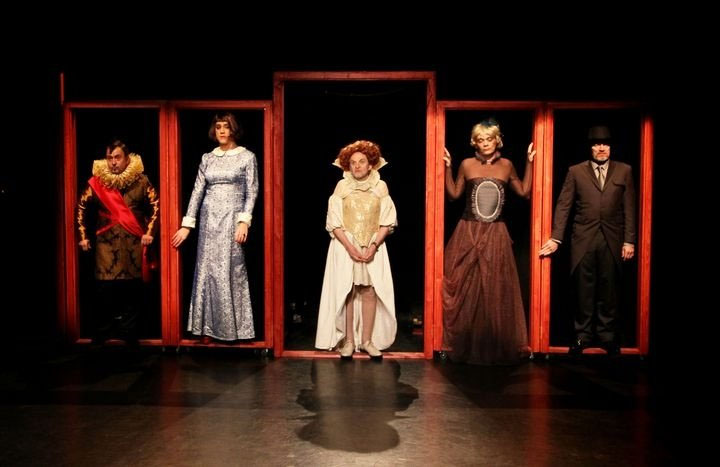A review of Szkéné Theatre’s production of Paul Foster’s Elizabeth I (dir. Szikszai Rémusz) by Bánovics Nóra
Paul Foster’s Elizabeth I is not a well-known play. It was written in 1972 but it was not and is not performed frequently even nowadays. Yet we can see it here in Hungary, in one of the smallest theatres, Szkéné located in the central building of the Technical University of Budapest. The first thing that will draw one’s attention is the intimate atmosphere of the theatre. Szkéné does not have a traditional stage: actors use the bare floor in what is more like a slanting, medium-size lecture room than a theatre’s auditorium. The advantage of this seat layout is that no matter where you sit you can fully appreciate every little detail, every nuance in the actors’ performances.
The production’s uniqueness lies in the fact that all the female characters are played by men just as in Elizabethan times. Moreover, Forster’s drama is not only a play; it features a play within the play, too. First we see the characters presented (as if on a catwalk) and we might think that that will be all that frames the performance. However, a few minutes later we realise that the characters play actors in the play itself. They travel around the country dramatizing the life of Elizabeth I, and the political affairs of the age interrupt their performance from time to time. That is how we slowly get to know the life of the itinerant English actors, dependent upon the favour of the audience, the patrons and the censors, which may be more important than the play about Elizabeth’s rivalry with Catherine Medici and Mary Stuart.

The Elizabethan all-men troupe.
Another aspect that speaks of the uniqueness of the production is that when the parts of the real play about Elizabeth I are acted out, we viewers become the Elizabethan audience. Actors talk to us, refer to us, and we are involved in the performance. Although some prior knowledge of the historical background might be useful in order to follow the story and understand everything, the production does a great job of representing Elizabethan theatre and creating an atmosphere that lets the audience experience it. We can imagine what it would be like if we lived in the 16th century, went to the Globe Theatre and watched a performance. It could be continuous time travel if the play within the play was not interrupted by the scenes from the lives of the actors.
 The production’s (not Forster’s) emphasis is on humour. From the beginning to the end we laugh at how ridiculously good-looking and credible these men in women’s clothes are and at the modern language they use. Although they use many obscene words the audience does not feel that it is rude or excessive because they use them so naturally and in situations where we would also use them in our everyday life..
The production’s (not Forster’s) emphasis is on humour. From the beginning to the end we laugh at how ridiculously good-looking and credible these men in women’s clothes are and at the modern language they use. Although they use many obscene words the audience does not feel that it is rude or excessive because they use them so naturally and in situations where we would also use them in our everyday life..
Despite the emphasis on humour, the play does not end on a happy note because Elizabeth’s death disbands the company. The actors are sent to serve on the galleys and we realise that the power struggle between theatre lovers and Puritans, artists and blockheads suddenly ended. Its consequences will determine the lives and actions of the actors, and people in general. Perhaps ours, too.
Read our other Elizabeth I reviews here, and all theatre reviews here!
Images taken from fidelio’s Elizabeth I gallery, photographed by Puskel Zsolt.


